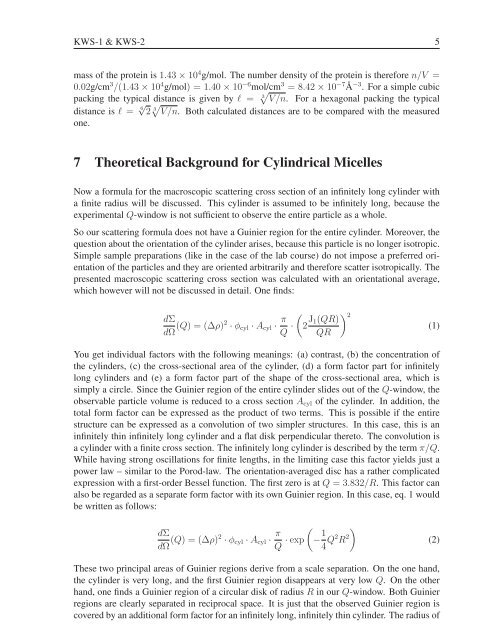Neutron Scattering - JUWEL - Forschungszentrum Jülich
Neutron Scattering - JUWEL - Forschungszentrum Jülich
Neutron Scattering - JUWEL - Forschungszentrum Jülich
Create successful ePaper yourself
Turn your PDF publications into a flip-book with our unique Google optimized e-Paper software.
KWS-1 & KWS-2 5<br />
mass of the protein is 1.43 × 10 4 g/mol. The number density of the protein is therefore n/V =<br />
0.02g/cm 3 /(1.43 × 10 4 g/mol) =1.40 × 10 −6 mol/cm 3 =8.42 × 10 −7 ˚A −3 . For a simple cubic<br />
packing the typical distance is given by ℓ = 3� V/n. For a hexagonal packing the typical<br />
distance is ℓ = 6√ 2 3� V/n. Both calculated distances are to be compared with the measured<br />
one.<br />
7 Theoretical Background for Cylindrical Micelles<br />
Now a formula for the macroscopic scattering cross section of an infinitely long cylinder with<br />
a finite radius will be discussed. This cylinder is assumed to be infinitely long, because the<br />
experimental Q-window is not sufficient to observe the entire particle as a whole.<br />
So our scattering formula does not have a Guinier region for the entire cylinder. Moreover, the<br />
question about the orientation of the cylinder arises, because this particle is no longer isotropic.<br />
Simple sample preparations (like in the case of the lab course) do not impose a preferred orientation<br />
of the particles and they are oriented arbitrarily and therefore scatter isotropically. The<br />
presented macroscopic scattering cross section was calculated with an orientational average,<br />
which however will not be discussed in detail. One finds:<br />
dΣ<br />
dΩ (Q) =(Δρ)2 · φcyl · Acyl · π<br />
Q ·<br />
�<br />
2 J1(QR)<br />
�2 QR<br />
You get individual factors with the following meanings: (a) contrast, (b) the concentration of<br />
the cylinders, (c) the cross-sectional area of the cylinder, (d) a form factor part for infinitely<br />
long cylinders and (e) a form factor part of the shape of the cross-sectional area, which is<br />
simply a circle. Since the Guinier region of the entire cylinder slides out of the Q-window, the<br />
observable particle volume is reduced to a cross section Acyl of the cylinder. In addition, the<br />
total form factor can be expressed as the product of two terms. This is possible if the entire<br />
structure can be expressed as a convolution of two simpler structures. In this case, this is an<br />
infinitely thin infinitely long cylinder and a flat disk perpendicular thereto. The convolution is<br />
a cylinder with a finite cross section. The infinitely long cylinder is described by the term π/Q.<br />
While having strong oscillations for finite lengths, in the limiting case this factor yields just a<br />
power law – similar to the Porod-law. The orientation-averaged disc has a rather complicated<br />
expression with a first-order Bessel function. The first zero is at Q =3.832/R. This factor can<br />
also be regarded as a separate form factor with its own Guinier region. In this case, eq. 1 would<br />
be written as follows:<br />
dΣ<br />
dΩ (Q) =(Δρ)2 · φcyl · Acyl · π<br />
�<br />
· exp −<br />
Q 1<br />
4 Q2R 2<br />
�<br />
These two principal areas of Guinier regions derive from a scale separation. On the one hand,<br />
the cylinder is very long, and the first Guinier region disappears at very low Q. On the other<br />
hand, one finds a Guinier region of a circular disk of radius R in our Q-window. Both Guinier<br />
regions are clearly separated in reciprocal space. It is just that the observed Guinier region is<br />
covered by an additional form factor for an infinitely long, infinitely thin cylinder. The radius of<br />
(1)<br />
(2)

















